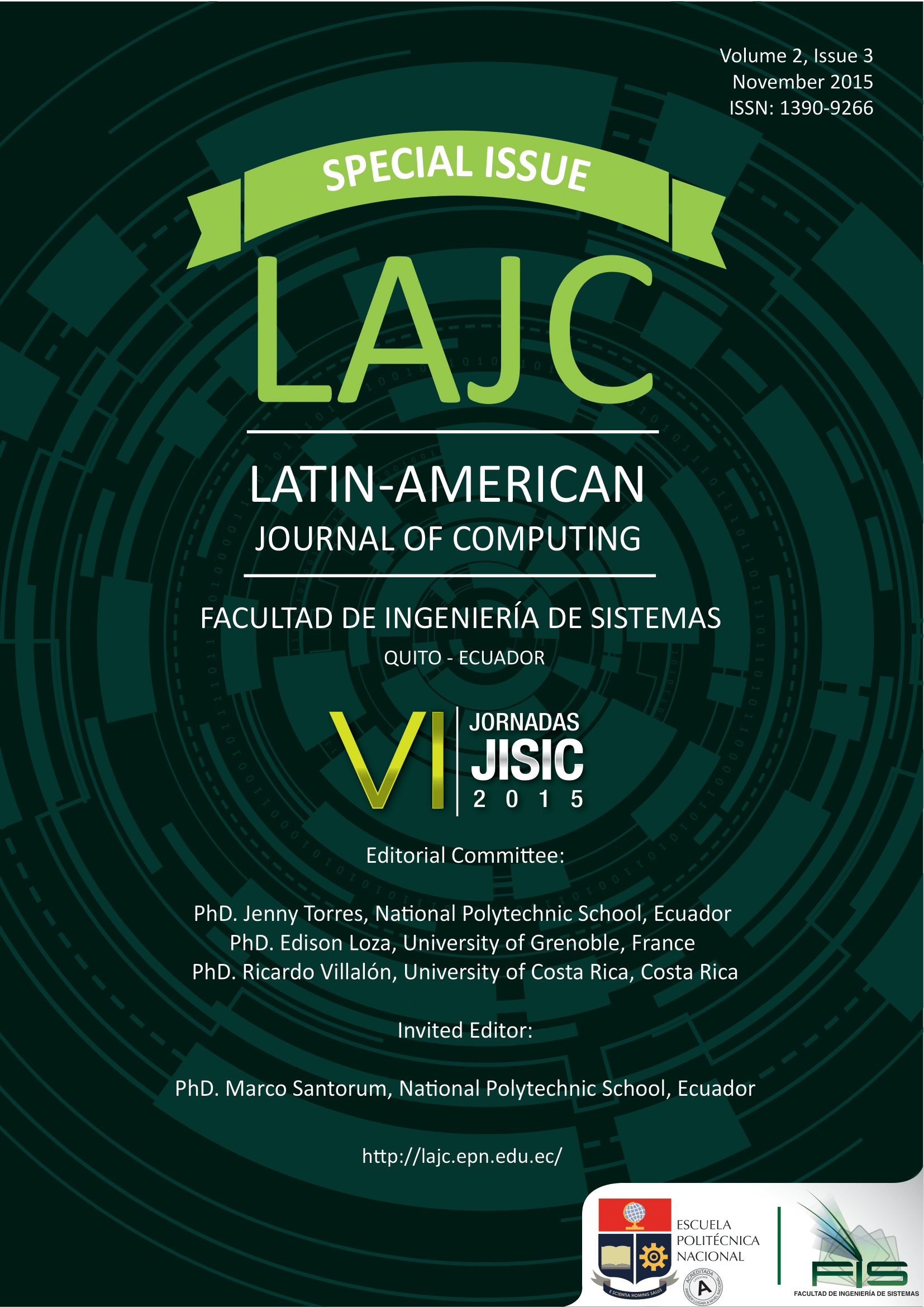Importancia de Accesibilidad Web en Mapas Geográficos para la Educación
Keywords:
Accesibilidad web, mapas geográficos, discapacidad, educación.Abstract
Este estudio presenta un análisis de las Pautas de Accesibilidad para el Contenido Web (WCAG 2.0) que pueden ayudar a mejorar la accesibilidad en los mapas geográficos, esto permite a estudiantes que tienen algún problema de discapacidad visual acceder al contenido geográfico. Para realizar este análisis se ha realizado un estudio del estado de arte de trabajos que aportan a esta investigación, además se presentan ciertas soluciones prácticas y herramientas que deben considerarse como es el uso de los Gráficos Vectoriales Redimensionables (SVG), el Lenguaje de Marcas de Hipertexto versión 5 (HTML 5) y las Hojas de Estilo en Cascada (CSS). También se presentan algunas recomendaciones para mejorar la accesibilidad web en los mapas geográficos y se proponen algunos trabajos a futuro.
Downloads
References
Google. 2013. What is the economic impact of Geo Services, Oxera.
Word Health Organization, 2013. Word Report on Disability. Available online: http://www.who.int/disabilities/world_report/2011/en/index.html.
World Wide Web Consourtion (W3C). 2012. Introduction to Web Accessibility. Available online: http://www.w3.org/WAI/intro/accessibility.php.
Carter, J. et al, 2001. Web accessibility for people with disabilities: an introduction for Web developers. IEEE Transactions on Professional Communication, Vol.44, No.4, pp.225-233.
Web Accessibility Initiative (WAI). 2014. Disponible en: http://www.w3.org/WAI/
World Wide Web Consourtion (W3C), 2008. Web Content Accessibility Guidelines (WCAG) 2.0. Disponible en:http://www.w3.org/TR/WCAG20/.
Las Pautas de Accesibilidad para el Contenido Web, 2008, Disponible en: http://accesibilidadweb.dlsi.ua.es/?menu=pautas-accesibilidad-contenido-web#arti-wcag2.
Krygier, J. And Wood D., 2011, Making Maps, A visual Guide to Map Design for GIS, ISBN 978-1-60918-166-6.
Geografia de España, 2015, Disponible en: http://webs.ono.com/2geografia/mapa.html
Cartographica: The International Journal for Geographic Information and Geovisualization, Volume 50 No. 1, Spring 2015, ISSN: 0317-7173; eISSN: 1911-9925
Cartography Topics and Projects , 2013, disponible en: http://mapmaker.rutgers.edu/355/links.html
Menno-Jan Kraak, Ferjan Ormeling, 2011, Cartography, Third Edition: Visualization of Spatial Data.
Mini Subreddit Dot Map Project, 2011, Disponible en: https://bit.ly/3GzpuMV
Topographic Maps, 2007, Disponible en: https://bit.ly/3HF3oKm
Isarithmic map, 2014, Disponible en: http://wiki.gis.com/wiki/index.php/Isarithmic_map
Tania Calle-Jiménez, Sandra Sanchez-Gordon, Sergio Luján-Mora. Retos de Accesibilidad en GEO-MOOCs. Atas da Conferência IADIS Ibero-Americana WWW/Internet 2013 (CIAWI 2013), p. 91-98, November 21-23, Porto Alegre, Brasil. ISBN: 978-972-8939-95-3.
Lujan-Mora Sergio, Accesibilidad Web, 2008, disponible en: http://accesibilidadweb.dlsi.ua.es/?menu=lectores
Bahram, Sina. 2013. Multimodal eyes-free exploration of maps: TIKISI for maps. ACM SIGACCESS Accessibility and Computing Homepage archive Issue 106, June 2013 Pages 3-11 ACM New York, NY, USA. DOI= 10.1145/2505401.2505402.
Wu Binzhuo, Xia Bin. 2005. Mobile Phone GIS Based on Mobile SVG. In Proceedings Geoscience and Remote Sensing Symposium. IGARSS '05. 2005 IEEE International.
Kaklanis, Nikolaos. et al. 2013. Touching OpenStreetMap Data in Mobile Context for the Visually Impaired. In Proceeding CHI 2013 Mobile Accessibility Workshop. April 28. 2013. Paris France.
Brisaboa, N.R. 2005. Improving Accessibility of Web-Based GIS Applications. In Proceedings Database and Expert Systems Applications, Sixteenth International Workshop on.. Page(s):490 –494.
Limin Zeng, Gerhard Weber.2010. Audio-Haptic Browser for a Geographical Information System. Computers Helping People with Special Needs Lecture Notes in Computer Science Volume 6180, 2010, pp 466-473.
Jing Su, et al. 2010. Timbremap: enabling the visually-impaired to use maps on touch-enabled devices. In Proceedings of the 12th international conference on Human computer interaction with mobile devices and services. Pages 17-26 .ACM New York, NY, USA.DOI= 10.1145/1851600.1851606
Poppinga, Benjamin, et al. 2011. TouchOver map: audio-tactile exploration of interactive maps. In Proceedings of the 13th International Conference on Human Computer Interaction with Mobile Devices and Services. Pages 545-550 ACM New York, NY, USA.DOI = 10.1145/2037373.2037458
Kaklanis , Nikolaos. et al. 2013. Touching OpenStreetMap Data inMobile Context for the Visually Impaired. In Proceeding CHI 2013 Mobile Accessibility Workshop. April 28. 2013. Paris France.
Bone, Christopher, et al., 2007. Thematic Tactile Maps. Available online:http://geog.uoregon.edu/geocog/products/tactile_thematic.html
Christensen S., 2001. How We Work to Make the Web SPEAK. Computers in Libraries, Vol. 21, No.9, pp.30-34 CHS, 2008. Confederación Hidrográfica del Segura-España. Disponible en:http://www.chsegura.es/chs/index.html.
Prougestaporn, P., 2010. Development of a web accessibility model for visually-impaired students on Elearning websites. International Conference on Educational and Network Technology ICENT, China, pp. 20-24.
Wooseob, J., 2008. Spatial perception of blind people by auditory maps on a tablet PC. Proceedings of the American Society for Information Science and Technology, Vol. 44, Nro.1, pp 1–8.
Sun, Z. et al, 2009. On Accessibility of Concept, Principle and Model of Educational Web Sites Design. International Conference on New Trends in Information and Service Science NISS'09, China, pp. 730-733. Transport Sydney Trains, 2010. Accessible Service. Disponible en:http://www.sydneytrains.info/travelling_with/accessible_services/
Burgstahler S., 2002. Real connections: Making distance learning accessible to everyone. Disponible en:https://www3.cac.washington.edu/doit/Brochures/PDF/distance.learn.pdf.
Sengupta, S., 2001. Exchanging ideas with peers in network-based classrooms: An aid or a pain. Language Learning & Technology, Vol. 5, No.1, pp.103-134.
Pouncey, I., 2010. Web accessibility for cognitive disabilities and learning difficulties. Disponible en:http://dev.opera.com/articles/view/cognitive-disability-learning-difficulty/.
World Wide Web Consourtion (W3C), 2008,Web Content Accessibility Guidelines (WCAG) 2.0
World Wide Web Consourtion (W3C), 2014, Accessible Rich Internet Applications (WAI-ARIA) 1.0. Available online: http://www.w3.org/TR/wai-aria/.
Downloads
Published
Issue
Section
License
Copyright Notice
Authors who publish this journal agree to the following terms:
- Authors retain copyright and grant the journal right of first publication with the work simultaneously licensed under a Creative Commons Attribution-Non-Commercial-Share-Alike 4.0 International 4.0 that allows others to share the work with an acknowledgement of the work's authorship and initial publication in this journal.
- Authors are able to enter into separate, additional contractual arrangements for the non-exclusive distribution of the journal's published version of the work (e.g., post it to an institutional repository or publish it in a book), with an acknowledgement of its initial publication in this journal.
- Authors are permitted and encouraged to post their work online (e.g., in institutional repositories or on their website) prior to and during the submission process, as it can lead to productive exchanges, as well as earlier and greater citation of published work.
Disclaimer
LAJC in no event shall be liable for any direct, indirect, incidental, punitive, or consequential copyright infringement claims related to articles that have been submitted for evaluation, or published in any issue of this journal. Find out more in our Disclaimer Notice.










